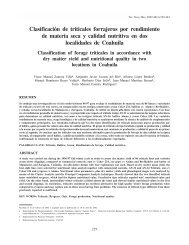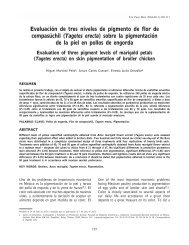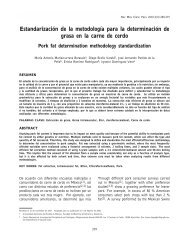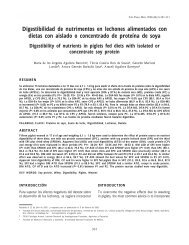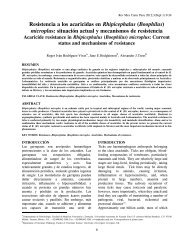Control de Rhipicephalus microplus - Revista Técnica Pecuaria en ...
Control de Rhipicephalus microplus - Revista Técnica Pecuaria en ...
Control de Rhipicephalus microplus - Revista Técnica Pecuaria en ...
Create successful ePaper yourself
Turn your PDF publications into a flip-book with our unique Google optimized e-Paper software.
Melina Maribel Ojeda-Chi, et al. / Rev Mex Ci<strong>en</strong>c Pecu 2011;2(2):177-192<br />
spp, Hirsutella spp, Hym<strong>en</strong>ostilbe spp, Isaria<br />
(=Paecelomyces) fumosorosea y Verticilliun<br />
(=Lecanicillium spp), pert<strong>en</strong>eci<strong>en</strong>tes a la clase<br />
Zygomycetes e Ascomycetes (28). Los hongos que<br />
han sido evaluados para el control <strong>de</strong> R. <strong>microplus</strong><br />
son L lecanii, C. bassiana y M. anisopliae, los<br />
cuales han <strong>de</strong>mostrado t<strong>en</strong>er pot<strong>en</strong>cialidad para el<br />
control <strong>de</strong> distintas fases <strong>de</strong> <strong>de</strong>sarrollo <strong>de</strong> la<br />
garrapatas (huevo, larva, ninfa y adulto) (5,29-31).<br />
METARHIZIUM ANISOPLIAE<br />
a) G<strong>en</strong>eralida<strong>de</strong>s<br />
Hasta hace ap<strong>en</strong>as unos años el género Metarhizium<br />
pert<strong>en</strong>ecía taxonómicam<strong>en</strong>te a la clase:<br />
Hyphomycetes, familia: Moniliaceae, género:<br />
Metarhizium y especie: anisopliae. Esta especie es<br />
un hongo <strong>en</strong>tomopatóg<strong>en</strong>o verda<strong>de</strong>ro anamorfo y<br />
facultativo, aislado por primera vez <strong>en</strong> 1879 <strong>de</strong>l<br />
escarabajo Anisoplia austriaca Herbst por<br />
Metchnikoff, qui<strong>en</strong> sugiere su uso por primera vez<br />
como ag<strong>en</strong>te microbiano para el control <strong>de</strong><br />
insectos (31). Actualm<strong>en</strong>te, se ha aislado <strong>de</strong> insectos,<br />
suelo, sedim<strong>en</strong>tos <strong>de</strong>l río y material orgánico <strong>en</strong><br />
<strong>de</strong>scomposición.<br />
La clasificación taxonómica <strong>de</strong>l género Metarhizium<br />
ha sufrido cambios <strong>de</strong> acuerdo a varios autores (32).<br />
Tulloch (33) clasifica a las especies <strong>de</strong> este género,<br />
con base <strong>en</strong> sus características morfológicas y<br />
reconoce dos especies: M. anisopliae y M.<br />
flavovori<strong>de</strong>. Driver et al (34) mediante estudios<br />
moleculares reconoc<strong>en</strong> <strong>en</strong> ambas especies <strong>de</strong> hongos,<br />
que exist<strong>en</strong> cuatro varieda<strong>de</strong>s M. anisopliae var.<br />
acridum, M. anisopliae var. lepidiotum, M.<br />
anisopliae var. anisopliae y M. anisopliae var.<br />
majus. Reci<strong>en</strong>tem<strong>en</strong>te, se propone (32) la exist<strong>en</strong>cia<br />
<strong>de</strong> nueve especies: M. anisopliae, M. guizhou<strong>en</strong>se,<br />
M. pingsha<strong>en</strong>se, M. acridum stat. nov., M.<br />
lepidiotae stat. nov., M. majus stat. nov., M.<br />
globosum, M. robertsii y M. brunneum. También<br />
los estudios filog<strong>en</strong>éticos han permitido reubicar a<br />
las especies <strong>de</strong> Metarhizium al grupo <strong>de</strong> los<br />
Ascomycetes (Hypocreales: Clavicipitaceae)<br />
parásitos <strong>de</strong> insectos, al consi<strong>de</strong>rar a<strong>de</strong>más el orig<strong>en</strong><br />
e implicaciones evolutivas como reproducción,<br />
hábitat, el uso <strong>de</strong> hospe<strong>de</strong>ro vivos y otros<br />
invertebrados como fu<strong>en</strong>te <strong>de</strong> alim<strong>en</strong>to (35,36,37).<br />
182<br />
facultative fungus. It was first isolated in 1879<br />
from the Anisoplia austriaca Herbst beetle by<br />
Metschnikoff, who first proposed its use as a<br />
microbial ag<strong>en</strong>t for the control of insects (31). So<br />
far, it has be<strong>en</strong> isolated from insects, soil, river<br />
sedim<strong>en</strong>ts, and spoiled organic matter.<br />
The taxonomic classification of the Metarhizium<br />
g<strong>en</strong>us has rec<strong>en</strong>tly be<strong>en</strong> subjected to changes (32).<br />
Tulloch (33) now classifies the differ<strong>en</strong>t species of<br />
this g<strong>en</strong>us based on their morphological features,<br />
and recognizes two species: M. anisopliae and M.<br />
flavovori<strong>de</strong>. Based on molecular studies, Driver et<br />
al (34) recognized that both fungus species inclu<strong>de</strong><br />
four varieties: M. anisopliae var. acridum, M.<br />
anisopliae var. lepidiotum, M. anisopliae var.<br />
anisopliae, and M. anisopliae var. majus. On the<br />
other hand, the exist<strong>en</strong>ce of nine species has rec<strong>en</strong>tly<br />
be<strong>en</strong> proposed: (32) M. anisopliae, M. guizhou<strong>en</strong>se,<br />
M. pingsha<strong>en</strong>se, M. acridum stat. nov., M.<br />
lepidiotae stat. nov., M. majus stat. nov., M.<br />
globosum, M. robertsii, and M. brunneum.<br />
Likewise, phylog<strong>en</strong>etic studies have led to relocating<br />
the various Metarhizium species within the insectparasitizing<br />
Ascomycetes (Hypocreales:<br />
Clavicipitaceae) by also consi<strong>de</strong>ring their origin<br />
and several evolution implications such as<br />
reproduction, habitat, the use of live hosts and<br />
other invertebrates as food sources (35,36,37).<br />
M. anisopliae attacks more than 200 species of<br />
insects and mites of differ<strong>en</strong>t g<strong>en</strong>uses within the<br />
Orthoptera, Hemiptera, Lepidoptera, Dermaptera,<br />
Hym<strong>en</strong>optera and Coleoptera classes, among others.<br />
In addition, M. anisopliae is known to have an<br />
effect on the following tick species: Amblyomma<br />
americanum, A. maculatum, A. caj<strong>en</strong>n<strong>en</strong>se, A.<br />
variegatum, <strong>Rhipicephalus</strong> annulatus, R. <strong>microplus</strong>,<br />
Hyalomma excavatum, Ixo<strong>de</strong>s scapilaris, R.<br />
app<strong>en</strong>diculatus, and R. sanguineus (30).<br />
M. anisopliae has the following abilities: growing as<br />
a saprophyte, spreading out by conidia, surviving in<br />
the soil, and exhibiting non-sexual reproduction (1,38).<br />
The optimum temperature for the growth of M.<br />
anisopliae is 25 to 30 °C, with a relative humidity<br />
of 100 % (31). The temperature extremes for M.<br />
anisopliae hyphal/conidial germination are



